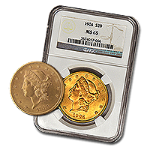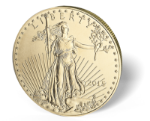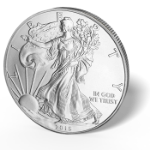All U.S coins have a U.S. Mint where they were minted or produced, but not every U.S. Coin has a mintmark. The story behind this phenomenon is somewhat simple, actually. The Constitution of the United States of America says that our money should be coined of gold and silver, and our Founding Fathers chose to coin both gold and silver in order to keep government and it’s spending in check.
In fact, the first public building ordered and paid for by the United States government was the smelt house of the newly commissioned Philadelphia Mint. The Mint was to be built in Philadelphia, Pennsylvania because in 1792 Philadelphia was the Capital City of the United States of America.
The Philadelphia Mint Has No Mintmark
When the original coin designs for the first American coins were engraved, no thought had been given as to whether or not there may be other U.S. Mints in the future, or whether or not there would be a need to distinguish the coins of one U.S. Mint from another. Therefore, there was no distinguishing addition to the design of the coin to identify where it was produced. To this day, coins produced by the Philadelphia Mint carry no mintmark. Six of the other eight U.S. Mints have chosen a single upper case letter from the English alphabet as their mintmark.
How Can Two U.S. Mints Have The Same Mintmark?
San Francisco coins are marked with an “S”. West Point coins bare a “W”. The gold and silver coinage produced by the New Orleans Mint was marked with an “O”. When the U.S. Mint in Charlotte, North Carolina was producing coins, they were marked with a “C”. The gold coins produced at the Dahlonega, Georgia Mint, when it existed, marked it’s coins with a “D”. The Mint in Denver, Colorado began to produce coins after the Mint in Dahlonega, Georgia ceased to exist, and for this reason could mark it’s coins with a “D” also.
Forget your “P’s” and “Q’s” and Know Your “D’s”!
The two United States Mints that share the “D” mintmark could not be more different. When Dahlonega was created by Congressional Act, construction and subsequent coin production began almost immediately, and all U.S. Mint functions ceased some 25 years later. This timeline means that Dahlonega is the U.S. Mint with the shortest production span as well as the lowest total coin production at just over 1.1 million pieces. Conversely, the Denver Mint existed as an institution some 40 years before the first official U.S. Currency was coined there. The Denver Mint would go on to produce more coins than any other mint in the world in addition to being one of the U.S. Mints with the longest continual production span.
The Dahlonega Mint produced only gold coins, whereas the Denver Mint has not produced a gold coin for circulation in nearly a century. The Denver Mint did produce both gold and silver coins in rather large quantities,especially when compared with the production of the Georgia Mint. Being that the Dahlonega Mint was only striking coins from 1838 through 1861, and the Denver Mint was not striking U.S. gold coins until the early 1900’s, any gold coin baring the “D” mintmark and a date from the 1800’s is gong to be very rare and quite valuable.
Nevada Just Has To Be Different....
Philadelphia didn’t even need a mintmark. Denver Colorado and Dahlonega, Georgia were content to share a “D”. Charlotte, North Carolina was happy being represented by a “C”. Even boisterous New Orleans, which could have insisted on an “NO” mintmark, opted for just a single, elegant “O”.
Carson City, Nevada however, broke tradition and ranks by choosing a two character mintmark, “CC”. To it’s credit however, the double “C’s” are easier to locate in coin designs than the single character mintmarks are. And compared to the non-existent Philadelphia mintmark that many novice and learned coin fanciers alike have spent untold amounts of time searching for, the CC mintmark is brilliant.
When A Mintmark Is Rare, Values Are High
In the world of valuable collector’s coins, significant value can depend on just two factors which combine to dwarf the value of the gold and / or silver held within the coin. These two factors are rarity and quality.
Are Quality And Condition The Same?
For the most part, the quality of an old coin is nearly synonymous with it’s physical condition. Old coins, especially soft gold ones, show wear caused by normal commerce and scar and mark quite easily. Coins that are free from the scars and marks of circulation are said to be “Uncirculated” in the coin world. If a coin was to be graded against what has become the standard in coin grading, the Sheldon Coin Grading Scale, and the coin was uncirculated, it would score a 60 or above. The Sheldon Scale tops at a perfect score of 70, and this is a perfect segue-way into the slight differences between quality and condition.
Quality
During the initial strike of a coin, several factors will come together to determine just how complete and perfect that strike, and therefore the coin, will be. Perhaps the biggest variable in this process is the die that the coin is struck from. Dies wear over time, and eventually hairline cracks and fissures develop in the dies, and these imperfections appear as flaws in the coin’s design. In addition to worn dies, worn or uncalibrated presses can also play a part in producing a coin that is less than perfect. And of course, operator error can enter into the process, and these presses were all run by hand back in the 18th, 19th, and 20th centuries.
Little imperfections like these are what the experts at PCGS (Professional Coin Grading Services) and NGC (Numismatic Guarantee Corporation) look for when they assign the grades between 60 and 70.Very few coins from the 1800’s and early 1900’s ever began life in a perfect “70” condition, and of course far fewer remain an example of perfect quality.
Rarity Is The King Of All Factors
In the numismatic world, or world of rare coin collectors and investors, generally speaking all things being equal a rare coin in poor condition is more valuable than a common coin in excellent condition. Besides the laws of supply and demand as well as the ever escalating prices and profits in the rare coin world, there are other reasons, such as privacy and estate planning strategies that make owning rare gold coins financially wise and somewhat contrarian.
Paper Investments And Bank Accounts Are Not Rare
Today’s cookie cutter paper investment products such as Certificates of Deposit (CD’s), 401k’s and IRA’s are completely different in theory and practice than owning rare gold coins. With paper investments, everyone signs the same forms, agrees to the same terms, gets the same interest rate, invests in the same companies, etc., etc. The amounts of CD’s that can be opened and the number of shares of stock that can be bought and the number of derivative accounts that can be created are unlimited, making these investments extremely common.
Don't Invest The Same Way Everybody Else Does, Or You Will All Go Broke Together
Being contrarian in your investment strategies can really pay off when the markets shift out of favor from common market investments, and wealth flows into physical wealth and commodities and away from paper and promises. We see this market phenomena play out time and time again when the stock markets crash and investors flee with whatever they have left and buy gold, real estate, oil, silver, and the like. After all, the Rockefellers, Buffets, and Trumps of this world did not make their fortunes by opening bank accounts and waiting for interest to compound, or making their maximum allowable annual IRA contribution. They struck out on their own and did what few others were doing. With their risks came their rewards and all three have owned gold one way or another.
What Is Rare?
There was a study done once that looked into how wealthy families were able to hold onto large fortunes over time, and especially how these family fortunes survived the coming and going of different rulers and the currencies that would come and go with their reigns. Studying the reasons that surrounded the ongoing prosperity of the wealthy family yielded an interesting conclusion; during times of government tribulations and currency devaluations these families would divide and invest their wealth equally into gold, real estate, and fine art. All of these things are rare.
Gold must be mined and is so rare it holds the technical term “precious metal”. Land, especially choice land, cannot be created or moved, and is therefore rare. Perhaps the most rare of these items is fine art, as usually only one of each piece of fine artwork exists. The wealthy knew that down the road, anything rare would hold it’s value, while currency and script that was being printed day and night on presses would become worthless very quickly, and they passed this knowledge onto the next generations.
How Can I Tell If An Old U.S. Coin Is Rare?
Short of memorizing key dates and key mintmarks, which numismatists and rare coin investors and buyers do, there are other ways to determine just how rare a particular coin may be. There are three pieces of information that you will need about the coin before you can begin to truly begin to track down the rarity of a particular old U.S. Coin; the date, the denomination or face value of the coin, and the mintmark which will tell you where the coin was struck.
The Date Of The Coin
Older is not necessarily better or more valuable in the old U.S. Coin market. The numbers of coins produced could vary greatly from year to year and U.S. Mint to U.S. Mint. Factors that may have heavily influenced production upwards may include the need for more coinage to effect commerce in a growing population, the need to coin great quantities of gold and silver being mined during booms, and the need for government expansion. Oftentimes war would slow or completely cease the minting of coins at a certain U.S. Mint or even all U.S. Mints, as was the case during World War I.
The date the coin was minted is usually on the front of the coin under the primary design of the coin. The date is usually given in English Numerals, although some U.S. Coins were struck with the date given in Roman Numerals. Finding Roman Numerals on an American coin is a pretty good sign that you have a rare U.S.Coin in your possession.
The Denomination Or Face Value Of The Coin
To determination of the denomination or face value of the coin is the easiest piece of information to glean, because it was meant to be obvious, more so than the date or the mintmark. The denomination may be on either the front (obverse) or rear (reverse) side of the coin. The value may be spelled out, or given in a numeral form, or even a combination of the two. At times, the term “Dollar” has been shortened and represented by the single capital letter “D” followed by a period so that it appeared “D.” on the coin. Unusual denominations, such as a half disme (yes, dime with an “s”), Two and-a-half Dollar coins, and Three Dollar coins may be a clue that you have a rare U.S. Coin in your possession.
So, What Is In A Mintmark?
The short answer is this: perhaps hundreds, thousands, or even tens of thousand of dollars may be represented by a single letter on a coin, or as you have learned, by a letter not being on a coin, as in the case of the Philadelphia Mint. Now that you know exactly what a mintmark is, what it means, and where to look for it, you have begun to understand the little nuances in rare coins that can begin to make the difference between an old coin worth a few hundred dollars and a truly rare coin which may be worth millions.











